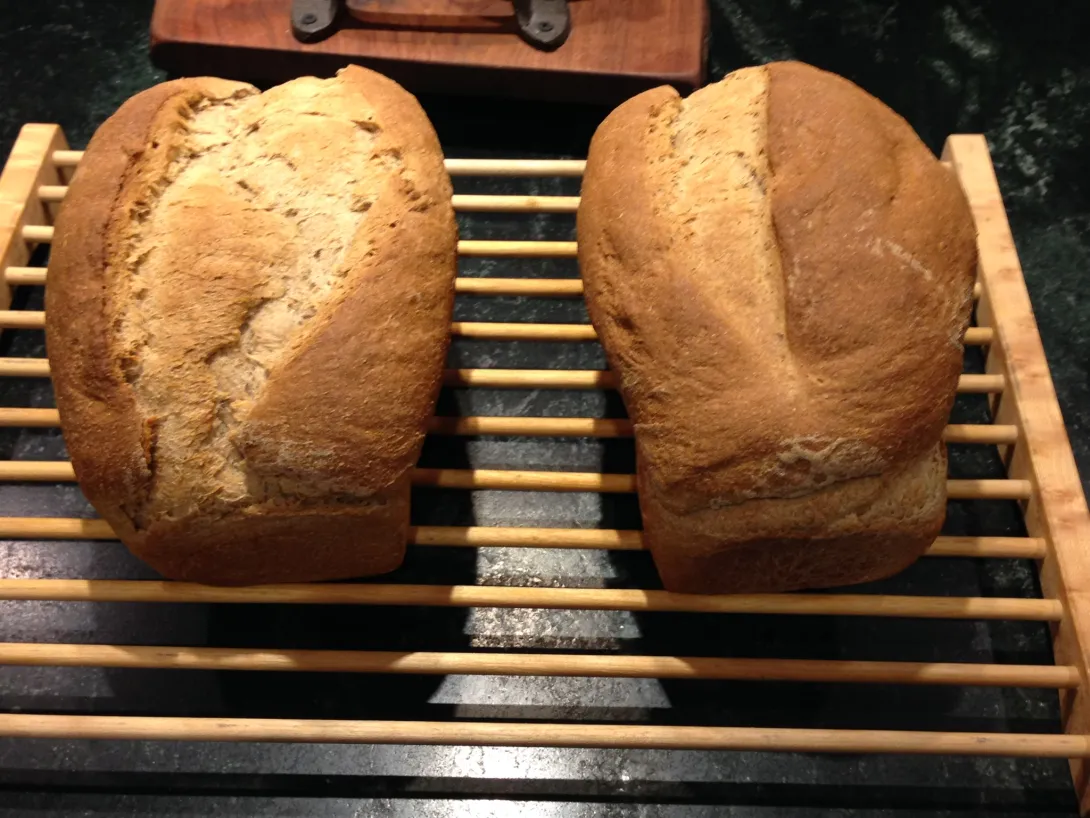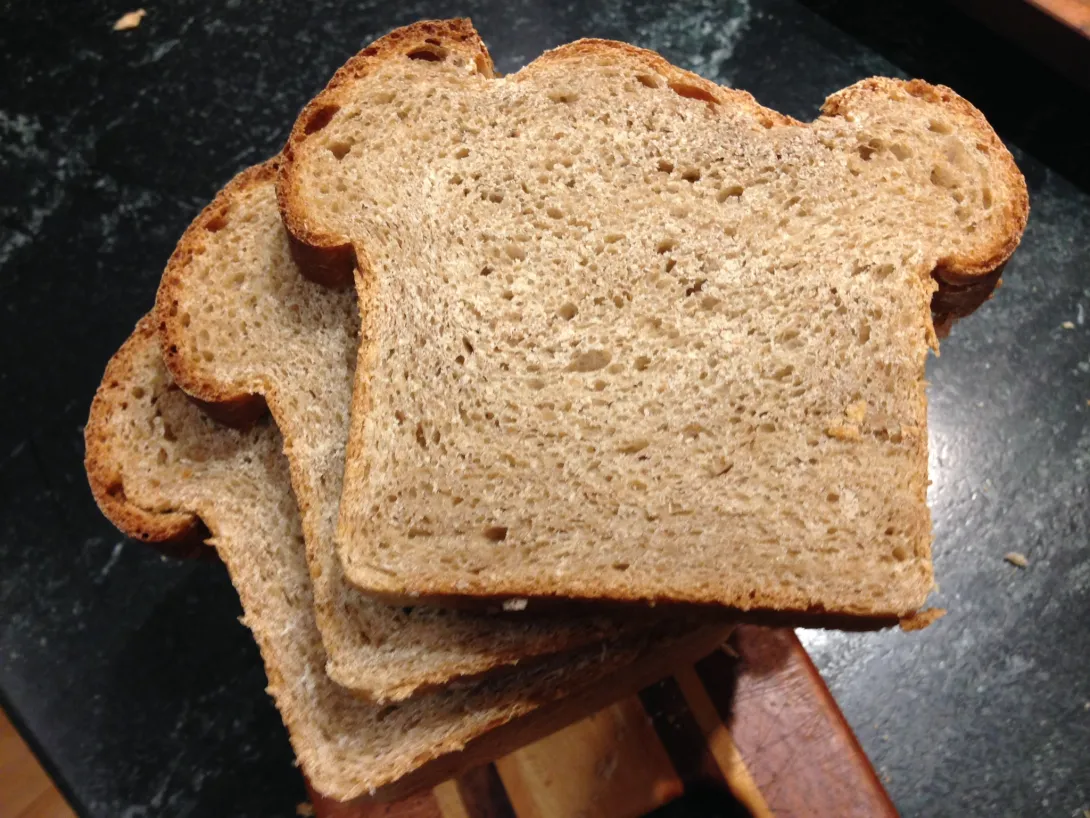
One of my Christmas gifts this year was several pounds of barley and of oats to feed my home milling habit. After noodling around here on TFL and the web, I cobbled together a formula to use some barley flour.
Ingredients
400g whole wheat flour, freshly milled
400g whole barley flour, freshly milled
400g all purpose flour
5g malted grain (I used malted barley)
900g water
60g honey
24g salt
10g active dry yeast
Process
Autolyse the flours, malt, water, and honey for 30 minutes. Mix the salt into the dough. Mix the yeast into the dough. Do three sets of stretch and folds at 20-30 minute intervals. When the dough has doubled from its original volume, divide into two pieces. Shape the loaves and place them in prepared bread pans. (I used 8x4 pans but this amount of dough will be more at home in two 9x5 pans.) Ferment the loaves until they have nearly doubled, then bake in a preheated oven at 375F for 50-60 minutes until the internal temperature reaches 195F.
Notes
Overall, I’m pleased with this bread, considering it was very much a seat of the pants experiment with a flour that I don’t know well. It rose well, is moist, and has a lovely flavor that is milder than a whole wheat bread. The honey isn’t enough to make the bread sweet but it does play up the other flavors. The texture is firm. Although the bread is somewhat more prone to crumbling than an all-wheat bread, it holds together fairly well.

The crumb is more open than I had expected, perhaps because of the stretch and folds instead of a more vigorous kneading. The compression visible around the edges is due to excess dough for the pan size, rather than over proofing. Judging from the oven spring, it may actually have been mildly under proofed.
I will play with this again. I'm curious to see how molasses would combine with the other flavors, for instance. At 33.3% barley flour, it probably isn’t worth pushing for higher percentages. It is a hefty bread as is and the crumb openness would suffer with an increased barley content. I also wonder if I might nudge the diastatic malt content slightly higher. That might improve the crust browning.
If anyone has pointers, I’m open for suggestions.
Paul
- pmccool's Blog
- Log in or register to post comments
and I be they are delicious plain and toasted....
Your questions are above my baking pay grade. Why would you want to up the malt content just for the browning? If so why not use 5-10% rye which i finds helps my crusts to brown?
As for molasses, I find the taste of molasses very strong and I would be afraid it would overwhelm the taste.... but that's just me.
Nicely baked. Wish I could taste it.
hester
My notion with the diastatic malt was that it breaks starches into sugars. Increased sugars in the dough lead to better crust browning. In addition, neither the whole barley or the whole wheat flours were malted; only rh AP flour was. It's a balancing game though, since too much diastatic malt can create a gummy crumb.
Another route to the same destination would be to add more honey or non-diastatic malt syrup or other sugar source. Again, more sugar yields more crust browning.
Or I could forego the malt, dial way back on the yeast, and do a cold ferment (very much like pain a la ancienne). Same eventual result.
Molasses is a flavor that I enjoy but it would have to be used judiciously to avoid overwhelming the other flavors, as you note.
Paul
Paul, I once spoke with a baking hotline and was told not to use Diastatic malt on freshly ground flour as it would ferment too quickly. So, that wasn't accurate ? Would appreciate your knowledge on this.
Nancy
Whole grain flours, in general, ferment faster than their white flour siblings. Diastatic malt, in and of itself, won’t promote faster fermentation but the sugars that it releases from the starches will definitely give the yeasts more food to use. That may have been what the baking hotline was thinking of.
This dough did move fairly quickly, considering that my kitchen was about 68F. My conjecture is that the whole grain flours, which were 2/3 of the total, were a bigger factor than the malt was.
My comparative ignorance of barley flour leaves me guessing about its effect on fermentation, as compared to wheat flour.
So much too learn.
Paul
Nice experiment that has to taste great. Well done and happy baking Paul
Feel free to adapt it to your wife's preferences, dab.
Paul
is my favourite flour after sprouted black quinoa flour. It does taste quite mild but I enjoy the subtle malty sweetness it contributes to bread. I think you're right about not pushing the barley % further: 30% is about the upper limit for low gluten / gluten free flour. Sadly, compromises have always been part of the baking experience.
Did you steam the oven? I guess that might give you a shinier crust from starch gelatinization. I'm not sure about the browning part though... Personally, I don't find diastatic malt very promising.
Nice bake!
Since the bread was baked in pans, I did not steam the oven as I would have for loaves baked on a stone.
I completely agree about the subtlety of barley's flavor. It might bake worth my doing a bake without the whole wheat flour just so that it doesn’t compete on my tongue with the barley. I am sure that there will be several iterations before I get to a version that I like better than any of the others. At least they will all taste good while I experiment.
And yes, I see no value I. Pushing the barley content further for a sandwich style loaf. I am curious, though, about whether high-percentage barley breads hold any allure like high-percentage rye breads do...something of a barley analog for pumpernickel, maybe?
Paul